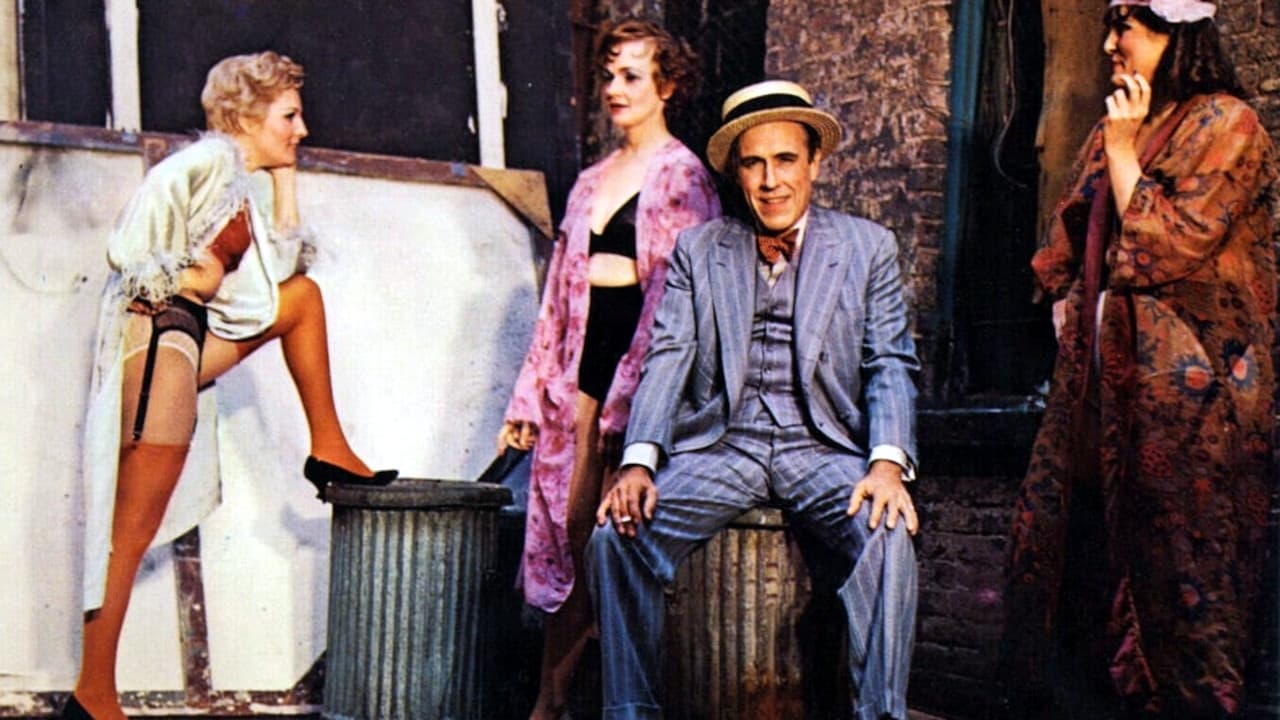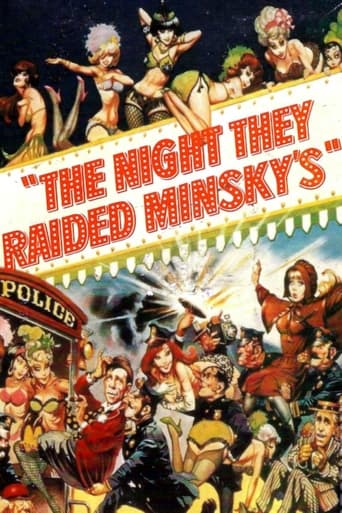



Wonderfully offbeat film!
After playing with our expectations, this turns out to be a very different sort of film.
View MoreEasily the biggest piece of Right wing non sense propaganda I ever saw.
View MoreThe movie really just wants to entertain people.
"The Night They Raided Minsky's" is a sheer delight to watch. It is definitely a timepiece in so many ways. On one level, it is a tribute to the Burlesque of the 1920s (it's set in 1925). Here, we get stellar performances from Bert Lahr, who died during shooting; Jason Robards; Norman Wisdom; and Joseph Wiseman, among others.But on another level, it's also a timepiece of late 1967, and we see that in the sense of wonder that Britt Ekland's character experiences. It runs like a sort of "Alice In Wonderland" for the Jazz Age. You can also see that in the photography from '67 as well. It is also a timepiece in that it was a film that no longer obeyed the Hays Code, which was ending around this time.And it's also a timepiece in that some of the New York exteriors used for filming were torn down after shooting ended. As stated earlier, it was Bert Lahr's final performance, and it is a memorable one. Had he lasted to the end of the shoot, his character would have loomed larger, but that was not meant to be.As it is, the movie could have turned into a disaster, but skillful editing turned what might have been a sow's ear into a gem of a film. Highly recommended.
View MoreA gorgeous Amish girl, Rachel (Britt Ekland) leaves the sect and comes to New York to dance, and winds up at Minsky's Burlesque House in "The Night They Raided Minsky's." Wide-eyed and innocent, she explains that she dances to portions of the Bible. When she shows what she can do, well, it's not burlesque.But this gives Raymond (Jason Robards), one of the comics, an idea. A group wants to close down the burlesque house because they think the numbers are indecent. If they announce a star from Paris, Madame Fifi, and send Rachel out with her Bible dances right as the place is being raided, it should put an end to the raids.Meanwhile, Rachel's father (Harry Andrews) is looking for her.This is a wonderful cast that includes, besides those mentioned, Elliot Gould, Forrest Tucker, Bert Lahr, and Denholm Elliot I guess I thought there would be a little more story to this film, instead of so many burlesque numbers. It's just a matter of taste. I've just never been that fond of burlesque.Sadly Bert Lahr died during this film, so his part was shortened and he was replaced.The end is very good, with the invention of the striptease. If you're a fan of burlesque, you will love this film.
View MoreJust a mere coffee break before William Friedkin made an almost consecutive string of such searing naturalistic dramas as The Boys in the Band, The French Connection, The Exorcist and Sorcerer, he showed up with The Night They Raided Minsky's, a low-brow farce which belongs in the pantheon of other throwback vaudevillian screwball romps from the Technicolor 1960s and early '70s, as in Take the Money and Run, the Pink Panther films, What's New Pussycat, It's a Mad Mad Mad Mad World, Bananas and What's Up, Doc? It shares the lagging sense of pace that some of them do---cursing those with one major inferiority to the 1930s and '40s pictures they embrace---as well as the urge to take what could be effective scenes and mash them into clunky montages. It also cannot remotely compare to What's Up, Doc?, the crowning achievement of this trend of the era helmed by Friedkin's New Hollywood rival Peter Bogdanovich. But The Night They Raided Minsky's is not without a secure handling of its risqué content by a director who was hungry for big risks in a period of American cinema where progress was entirely fueled by them.Instrumental in the commercial transformation of Hollywood in only a few short years, Friedkin's films often display a cold cynicism which belies the popular appeal of his future short-lived commercial success. The Night They Raided Minsky's is of a completely different spirit. It is a star-studded ensemble farce, fueled not so much by the breathtaking nature of any scene or story point but by the archetypal bearings of its performers. We have Elliott Gould delightfully playing up his deeply recognized Jewish identity, Denholm Elliott lovingly drawing from his always readily apparent English manners, Jason Robards working his all-American common-man staple. But whether stand-alone scenes work in and of themselves or not, the movie altogether truly appears to grasp this most-American art form.Supposedly, burlesque surged in an era when America was at the onset of the modern moral uprising, when the rural Puritan standards and the makeshift culture of the cities came across one another. Burlesque was basically vaudeville and sex, and in the early days the sex was straightforward, guileless and practically inoffensive. This is the charm of this film, not the pratfalls, the jokes or the farce, even when they work well, which is where Friedkin's stamp really shows itself: Like a Friedkin picture, it is about more than it acts like it is. Friedkin recounts that very period, when there was an exhilaration and flourishing, boisterous burlesque that later vanished. His characters live a talkative, communal life, occupying cafeterias and eating outlandish, hysterically filmed meals. They view burlesque not so much as a profession, more a lifestyle.The plot involves a young Amish girl played by Swedish future Bond doll Britt Ekland, who comes to the big city and is overwhelmed by the flashing marquees. The film opens with Rudy Vallee telling us in a vaudeville style that what we're about to see is based on "really true incidents that actually happened," that "in 1925 there was this real religious girl this real religious girl." Black-and-white images of Model A's on hectic streets, a dancing horse, acrobats, and numerous other impressions whip by, ultimately beholding a lively market street teeming with peddlers and pushcarts that bursts into color. There's a close-up on Ekland riding in bright-eyed on an el train. Her point-of-view peering out at the tenement-lined street erupts from black-and-white to color, as does her making her way down that street. She imbibes the zest and ambiance of a novel world, swarming but exhilarating. Austere gray skies but a vividm multihued event interspersed by more color swings visually signifying her inexperience.Friedkin captures her coming in his naturalistic style of pursuing and exposing action. Her discovery of countless faces, vendors, merchants and ultimately the Minky's Burlesque Theater, is our discovery, too. We become partakers rather than just watchers. And the awareness to minutiae webs with our point-of-view on the marquee dropping to show Bert Lahr chomping a cigar, about to befriend the virginal greenhorn whose perspective we've shared.She longs to dance at Minsky's. She is fought over by two comics (Norman Wisdom and Jason Robards), bird-dogged by her bearded, religious zealot father, and she suddenly, unwittingly and yet glamorously pioneers the striptease. And that moment when she finally invents the strip dance mostly to defy her father and other possessive male figures speaks so many volumes about the futility of utter conservatism and fundamentalism, how the more it pushes and the more it engulfs, the more shocking and extreme each explosion of rebellion and revolution will be, which of course is not to say that the scene itself threatens anything over PG-13 material, but the subtext is there.Friedkin has intentionally employed stereotypes in casting. Ekland is as dovelike and guileless as Joan of Arc and her father is an emigrant from an Early Renaissance allegorical drama. So the story itself takes on some of the reduction and directness of the burlesque skits which freely exposes the action, which tends to compensate for the film's weakness since the editing often becomes a bit too unnecessarily frenzied rather than gazing decisively on the impact of a given image or scene.
View MoreAnd I mean that most sincerely, this is one of the great films of the 1960s, charting the last days of the burlesque music-hall theatricals in America. The plot of the film is something of a mish-mash, mixing up Britt Ekland as an Amish runaway who finds herself onstage, with Denholm Elliot as a moralistic do-gooder trying to close down Minsky's theatre, but in truth, as with a large number of films of the period (see also The Pink Panther films), the plot is merely a convenience, a washing line upon which to hang a large number of characters, theatrical set-pieces and little illustrations of life in and around the theatrical world. A host of fine actors grace the screen, with Elliot Gould making an early appearance as Minsky jr, Harry Andrews as Ekland's glowering father, Joseph Wiseman as Minsky sr and most affectingly, Bert Lahr in his final screen performance. Even Ekland is OK, and it takes a lot to say that. But at the centre of it all are Jason Robards and Norman Wisdom as the theatre's chief comedy double-act. An odd pairing that works amazingly well, with Robards an effectively sleezy straight man (his seduction of Ekland is both funny and stomach churning). But if Robards is good, Wisdsom is fantastic, his comedic skills honed in England finally being given full rein (I enjoy a lot of his British films, but few of them really allow him full use of his abilities), and the song and dance routine and when he defines burlesque to Ekland rank as his finest on-screen moments. it's a bitter shame that the failure of this film and personal circumstances forced him to leave Hollywood, because with the right material he could have gone so much further. Truth is, if you have no sympathy for this sort of material, this will not change your mind. But for an utterly unique film, packed with beautiful little minutiae of theatrical life and a great mix of dark humour and bawdy comedy, this is really something to be cherished.
View More